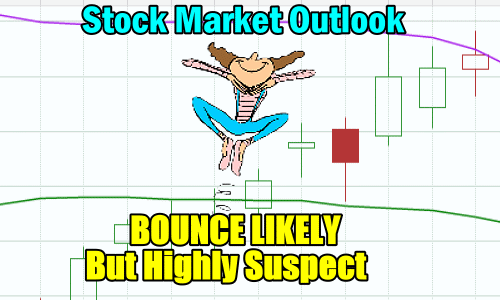
Stocks collapsed again on Friday and ended at the lows of the day and within easy reach of the Feb and March lows.
The S&P fell 155 points for a 3.6% loss to close at 4131. The NASDAQ fell 536 points for the worst one day drop since Feb 3. The Index closed at 12,334..
Amazon.com was one of the catalysts behind the drop, following disappointing earnings on Thursday after the close. Amazon.com fell 406 points for a 14% drop, closing at 2485.63 and leaving the stock at valuations last seen in June 2020. Many other stocks followed Amazon.com’s lead including AbbVie Stock (ABBV) which fell 6% following an earnings miss Friday morning along with a lowering of their forward guidance.
Qualcomm Stock (QCOM) fell 5.74% and Costco which had been a leader continued its plunge on Friday, falling $30 for a 5.3% loss. Costco is down 13% just since April 7 when it made a new all-time high of $612.27.
April 2022 was one of the worst April’s on record. It is also known as the final month of the so-called best 6 months of the year but this year it did not live up to its expectations.
Let’s review the closing technical indicators from Friday for the S&P to see what we should expect for the start of the month of May.
Stock Market Outlook Chart Comments At The Close on Fri Apr 29 2022
On Friday the closing candlestick was a long red bearish signal. It does however point to an oversold market and with the index pretty well at the lows of the ongoing correction, there is a good chance for a bounce, but the chance it will hold is still slim.
On Friday another new down signal came into play as the 21 day moving average fell below the 200 day which is a strong down signal. The last time it fell below the 200 day was March 7.
There are no up signals left in the SPX at present. The moving averages are all bearish.
The Upper Bollinger Band is trending sideways while the Lower Bollinger Band is continuing to fall. This is bearish.
With all the moving averages falling, the chart is pretty well 100% bearish. That’s why a bounce is likely. If not on Monday, then on Tuesday.
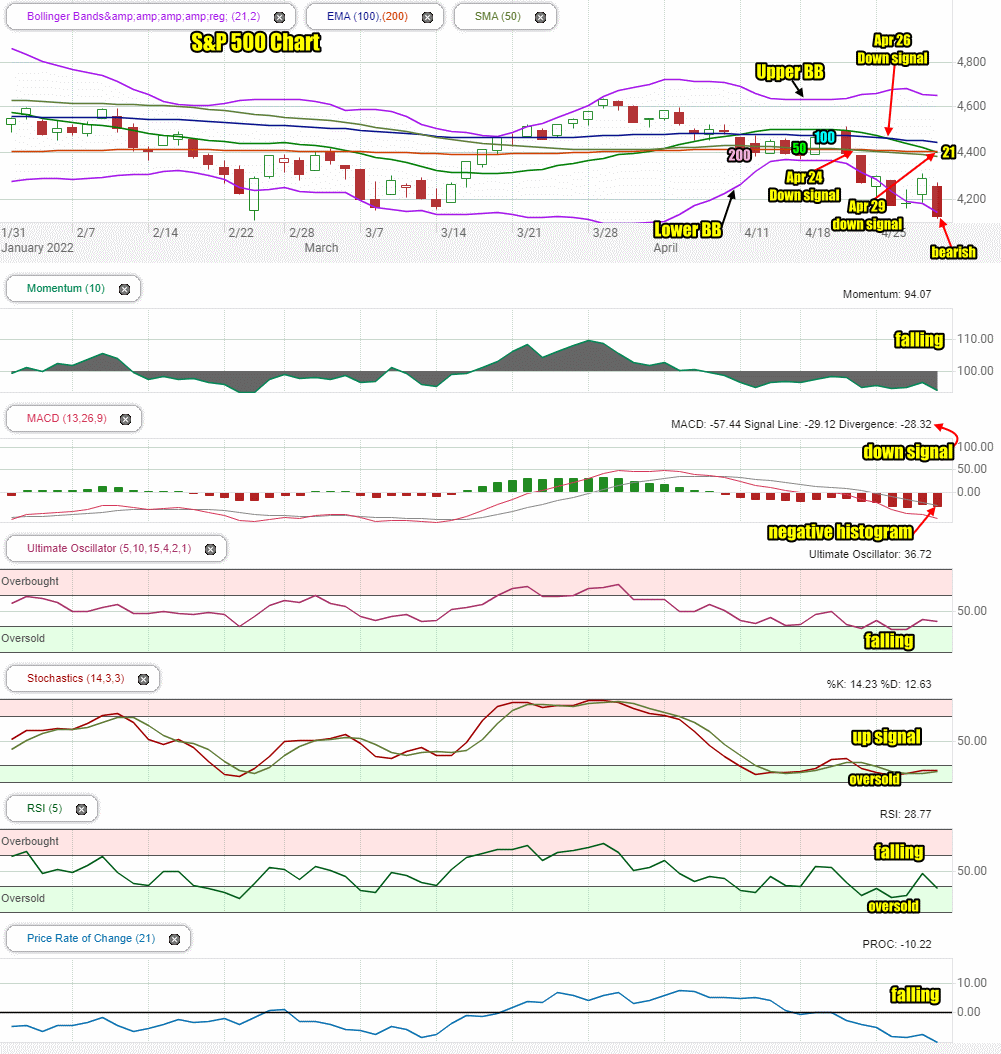
Stock Market Outlook review of Fri Apr 29 2022
Stock Market Outlook: Technical Indicators Review:
Momentum: Momentum is falling and negative.
- Settings: For momentum I use a 10 period when studying market direction.
MACD Histogram: MACD (Moving Averages Convergence / Divergence) issued a down signal Friday April 8. On Friday the down signal gained strength. The histogram also is very bearish.
- Settings: For MACD Histogram, I am using the Fast Points set at 13, Slow Points at 26 and Smoothing at 9.
Ultimate Oscillator: The Ultimate Oscillator is falling.
- Settings: The Ultimate Oscillator settings are: Period 1 is 5, Period 2 is 10, Period 3 is 15, Factor 1 is 4, Factor 2 is 2 and Factor 3 is 1. These are not the default settings but are the settings I use with the S&P 500 chart set for 1 to 3 months.
Slow Stochastic: The Slow Stochastic has a very weak up signal in place and is signaling oversold.
Settings: For the Slow Stochastic I use the K period of 14 and D period of 3. The Slow Stochastic tries to predict the market direction further out than just one day.
Relative Strength Index: The RSI signal is falling and back into oversold readings.
- Settings: The relative strength index is set for a period of 5 which gives it 5 days of market movement to monitor. It is often the first indicator to show an overbought or oversold signal.
Rate of Change: The rate of change signal is still falling.
- Settings: Rate Of Change is set for a 21 period. This indicator looks back 21 days and compares price action from the past to the present. With the Rate Of Change, prices are rising when signals are positive. Conversely, prices are falling when signals are negative. As an advance rises the Rate Of Change signal should also rise higher, otherwise the rally is suspect. A decline should see the Rate Of Change fall into negative signals. The more negative the signals the stronger the decline.
Support and Resistance Levels To Be Aware Of:
4550 is light resistance
4525 is light resistance
4500 is resistance
4490 is light resistance
4475 is light resistance
4450 is light resistance
4400 is resistance
4370 is light support
4350 is light resistance
4300 is light resistance
4290 is light resistance
4270 is light resistance
4250 was good support
4225 was light support
4200 is good support
4150 is good support
4100 is light support
4050 is light support
4025 is light support
4000 is good support
Stock Market Outlook for Tomorrow – Mon May 2 2022
With more and more stocks below their respective 200 day moving average, the majority of stocks have lost their gains made in 2021. The market is oversold and that means a chance for a bounce is again likely, bounces should be used to close trades and lock in profits and then wait for the next downturn to place capital back at work.
For Monday markets will probably try to bounce which will be perfect for the SPY call trade I tweeted about on Friday as I bought calls in the SPY Market Direction Portfolio. Meanwhile most of the puts bought in the SPY Market Direction Portfolio were sold out on Friday. Only a handful remain. On Monday if there is a bounce, especially a bounce to 4230 or 4240, I will again be buying SPY put options using May 13 expiry at the $400 or $405 put strike.
On Monday I expect a bounce attempt but it will be highly suspect of failing again. the S&P looks set to break 4100 and challenge the 4000 valuation this week.
This week is filled with market moving events, almost all of them could be negative. These culminate to the April unemployment report on Friday. This will be a tough week for stocks. This is why in any bounce on Monday or even Tuesday I plan to buy SPY put options. Just remember if buying put options, take profits and don’t try to “guess” how low the SPY could fall.
Potential Market Moving Events
Monday:
9:45 S&P Global US manufacturing PMI
10:00 ISM manufacturing index
10:00 Construction spending
Tuesday:
10:00 Job opening and quits
10:00 Factory orders
no set time: Motor vehicle sales
Wednesday:
8:15: ADP employment report
2:00 FOMC statement
2:30 Fed Chair news conference
Thursday:
8:30 Initial jobless claims and continuing jobless claims
8:30 Productivity and Unit Labor Costs (should give further evidence on inflation’s impact)
Friday:
8:30 April nonfarm payrolls and unemployment rate
8:30 Average hourly earnings (another inflation indicator)
8:30 Labor force participation rate
Stock Market Outlook Archives
Stock Market Outlook for Mon Nov 18 2024 – Choppy – Possible Bounce Attempt

Morning Investing Strategy Notes for Fri Nov 15 2024
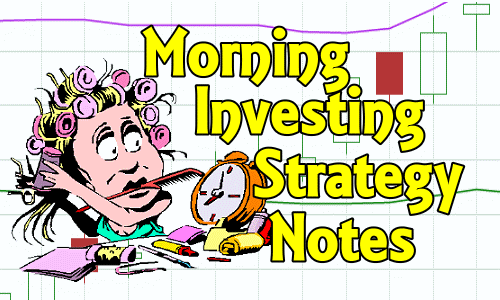
Stock Market Outlook for Fri Nov 15 2024 – Choppy With Bias Lower

Stock Market Outlook for Thu Nov 14 2024 – Choppy – Dips Possible But Higher Close

Morning Investing Strategy Notes for Thu Nov 14 2024

Morning Investing Strategy Notes for Wed Nov 13 2024

Stock Market Outlook for Wed Nov 13 2024 – Choppy Trading Bias Lower

Morning Investing Strategy Notes for Tue Nov 12 2024

Stock Market Outlook for Tue Nov 12 2024 – Overbought – Dips Likely But Bullish

Morning Investing Strategy Notes for Mon Nov 11 2024

Stock Market Outlook for Mon Nov 11 2024 – Overbought – Higher Still
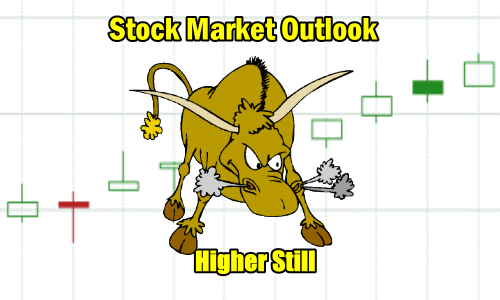
Morning Investing Strategy Notes for Fri Nov 8 2024

Stock Market Outlook for Fri Nov 8 2024 – Overbought – Dips Likely But Higher Close
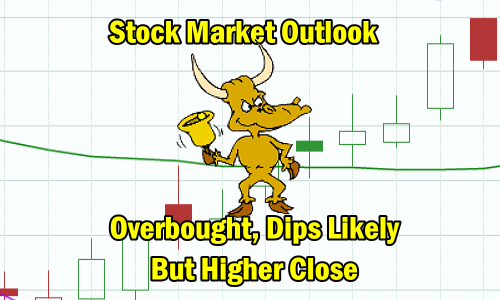
Morning Investing Strategy Notes for Thu Nov 7 2024

Stock Market Outlook for Thu Nov 7 2024 – All About The Fed – Higher

